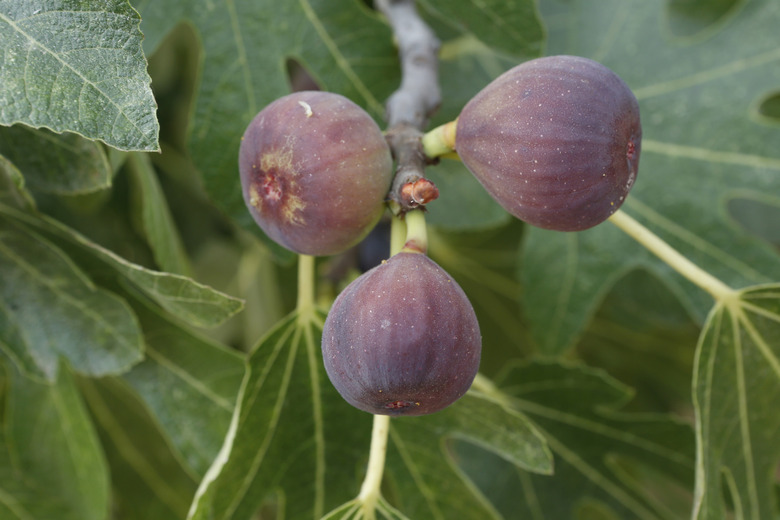Growing Fig Trees From A Seed
An ancient tree native to the Mediterranean and western Asia, the common fig (Ficus carica) grows to 30 feet with gray bark and lobed leaves up to 10 inches long. Its tiny flowers appear inside the 1- to 4-inch oval, cone-shaped or pear-shaped fruits that ripen to yellow, violet, brown or black. Generally only hardy in U.S. Department of Agriculture plant hardiness zones 7 through 11, the trees can survive as far north as USDA zone 5 when protected. If you wish to grow figs from seeds, you may need to purchase them because nonpollinated fruits usually won't contain them.
Understand Fig Propagation
Because fig shoots root easily, propagate the trees from cuttings if you wish to raise reliable fruit-producers as such cultivars won't come true from seed. (In other words, their seedlings won't necessarily look like — or fruit like — the parents.) Also, trees grown from cuttings can fruit their second year, while fig seedlings may take five to seven years to do so.
Some seedlings will be male as well and make only small, inedible fruits. Therefore, you should only start figs from seeds if you wish to raise them solely as decorative plants.
Because the common fig doesn't require pollination to produce mature fruits, not all cultivars available at the supermarket contain true seeds. Those imported from the parts of the world where they are native are more likely to have been pollinated.
Harvest Fig Seeds
Fig seeds vary in size but usually are quite tiny, often no more than 1 1/2 millimeters in diameter. To harvest them from fresh figs in late spring or early summer, soak the fruits in a bowl of water for 24 to 48 hours. After they have softened, pull them apart with your fingers.
Swirl the floating pulp in the bowl to encourage viable seeds to sink to the bottom, and soak both pulp and seeds for another 24 hours. Seeds that don't sink shouldn't be planted because they probably aren't viable.
Skim the floating pulp from the surface of the water and discard it. Line a kitchen strainer with a coffee filter, hold it over a sink and pour the water through the filter to capture the seeds.
Plant Fig Seeds
After filling a container that has drainage holes with sterile seed-starting mix, sow the still-damp seeds on the surface of that mix. Press them lightly into it without covering them, top the container with plastic wrap and place it under a grow light or on a sunny windowsill. If kept at a temperature near 77 degrees Fahrenheit, the seeds should germinate within two weeks to three months.
Grow Fig Seedlings
Until the seedlings are 1 month old, feed them with a half-strength balanced plant food once every two weeks. If you prefer an organic type, such as 3-3-3, mix 1 1/2 teaspoons of the solution into 1 quart of water. For a chemical 20-20-20 variety, use 1/4 teaspoon of the crystals per quart of water or whatever amount is indicated on the label. After the seedlings' first month, increase the amount of the plant food to full strength.
When the figs have four leaves each, transplant them into individual seedling pots filled with a quality all-purpose potting soil. Keep seedlings indoors during their first winter, either on a sunny windowsill or under a grow light timed to run for 14 to 16 hours per day. Stop feeding them during the winter, and resume feeding again in early spring.
After the last spring frost, transplant the seedlings into the ground in zones where they are hardy, choosing a location that receives sunlight for at least eight hours per day and has sandy loam with a pH between 6.0 and 6.5. Gradually accustom the seedlings to the brighter light for several weeks before you plant them. Space them 10 to 20 feet apart, using the wider spacing if you prefer tree form to bush form, and make sure that they receive 1 to 1 1/2 inches of water per week.
References
- Bonsai Hunk: Ficus Techniques: 33: Growing Ficus (Figs) from Seeds?
- Purdue University: Fig
- Plants for a Future: Ficus carica – L.
- The Pictorial Guide to Seeds of the World; Terry A. Woodger
- Trees, Earth, and Torah: A Tu B'Shvat Anthology
- Growing Tasty Tropical Plants; Laurelynn G. Martin and Byron E. Martin
- The New Sunset Western Garden Book; Kathleen Norris Brenzel, Editor
- University of Georgia: Home Garden Figs
